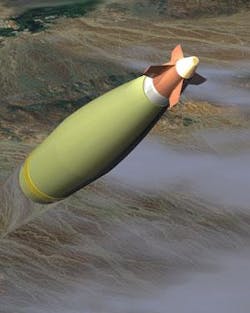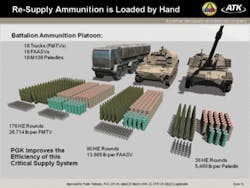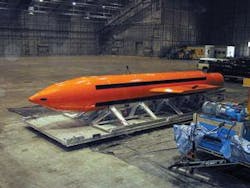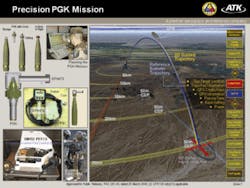Putting a smart bomb through a window during the first Persian Gulf War was just the beginning. Next up: smart bullets for infantry weapons, GPS receivers built into the soldier’s boot, eliminating enemy snipers before they have a chance to shoot, and counter-RPG systems.
By J.R. Wilson
Most of the world first became aware of the new era of precision guided munitions (PGMs) in the early days of the first Gulf war, when CNN correspondents, watching from the upper floors of their downtown Baghdad hotel, reported seeing an American missile fly down the street—and turn a corner.
The U.S. Army Precision Guidance Kit (PGK), shown above in a graphic depiction, replaces the fuse in the nose of conventional 155-mm artillery round to transform a dumb round into a precision-guided weapon.
The level of precision available in 1991, while revolutionary, is several generations obsolete less than two decades later. But what is now being developed in military and industrial labs will make today’s PGMs seem even more crude by comparison, in less than a decade. Perhaps much sooner.
In a progression from hitting a specific building to hitting a specific room, the next generation will, among other things, turn the foot soldier into a precision strike weapon, able to navigate without GPS thanks to a chip in his boot, and to fire guided bullets at targets like would-be snipers before they have a chance to fire at him.
Most PGMs today depend heavily on GPS for location and navigation, adding some advanced sensors for terminal target identification and guidance. Advances in inertial navigation systems (INS) also have added to the precision of weapons now deployed to Iraq and Afghanistan.
The future will be more focused on revolution than evolution, involving new technologies to enhance the precision of precision strike weapons. Most of these efforts are still in research and development—especially at the Defense Advanced Research Projects Agency (DARPA)—with a significant number expected to leave the lab for fielding in the next decade.
A wide range of precision strike-related programs are scattered among several DARPA offices, such as Defense Sciences (DSO), Strategic Technology (STO), Microsystems Technology (MTO), Information Processing Techniques (IPTO). Some may share components or break-through technologies or ultimately may be combined to achieve a specific goal.
Precision Inertial Navigation Systems (PINS)
PINS is an effort to address the vulnerabilities of GPS navigation—jamming, spoofing, blind spots, etc.—by using ultra-cold atom interferometers to reduce the positional accuracy drift of INS by several magnitudes to achieve near-GPS accuracies. Such a system could be used as a backup in case of GPS denial, or as an alternative to GPS on some platforms.
“I feel like atom interferometry is the core technology for future improvements in high-end INS. We have been looking very hard at global strike and this is a technology that is very promising in that realm,” says U.S. Air Force Lt. Col. Jay Lowell, PINS program manager within DSO. “If you set an INS down on a table, it thinks it is moving at one mile per hour, because that is the typical INS drift in an aircraft-size box. The smaller the box, the greater the drift. We’re looking for a 70x improvement in that drift—from a mile an hour to tens of meters an hour.”
Kits to convert conventional bombs and shells into smart munitions, like the JDAM and PGK munitions, can help reduce the need for excess ammunition by hitting targets with only one weapon.
Basically, an atom interferometer takes a cloud of about 1 billion Cesium or Rubidium alkali atoms and cools them to a temperature one-millionth of a degree above absolute zero. Lasers then launch those atoms into an ultra-high vacuum enclosure, where their path is measured.
“We use one laser beam to split the cloud of atoms, making them behave like they are in two places at the same point in time. We then use another laser pulse to recombine those atoms and, in that process, are able to determine the interference between the two paths that cloud took,” he says. “What happens during that time when the two atom waves are separated tells us about the inertial forces that have acted on those atoms. And that inertial force is what we are after in a navigation system.
“Our current challenge is to improve the sensor bandwidth to enable operations with a 10G input, so it is not only useful underwater, but will be a navigation technology available for aircraft and missile applications, as well. The predominant challenge is improving the sensor bandwidth, miniaturizing and integrating subsystems to enable that.”
This image depicts how smart munitions kits like the ATK PGK improve the logistics efficiency for artillery units.
The program is moving toward a targeted airborne test in about three and one-half years, he adds, while having a “routinely fieldable application around 2015 or 2016 is not out of the question.”
EXtreme ACcuracy Tasked Ordinance (EXACTO)
EXACTO uses a combination of a maneuverable bullet and a real-time guidance system to track the target and deliver the projectile to target. Technology development includes the design and integration of aero-actuation controls, power sources, and sensors, according to DARPA. The components must fit into the limited volume of a 50-caliber projectile and be designed to withstand a high acceleration environment. The EXACTO technology is planned for transition to the Army by 2012.
Based on a new .50 caliber BMG gun and improved scope, EXACTO would incorporate a variety of technologies, including fin- and spin-stabilized projectiles, internal or external aero-actuation control methods, projectile guidance technologies, tamper proofing, small stable power supplies, as well as advanced sighting, optical resolution, and clarity.
“DARPA’s goal is to remove the effect on accuracy of target motion and random variances in the environment through use of a guided bullet,” explains DARPA program manager Dr. Lyn Beamer (IPTO). “Such variances cannot be accounted for in the initial aim point and include unknown winds, range-to-target, altitude differences between shooter and target, and round-to-round differences, among other factors.”
One benefit is that EXACTO no longer requires snipers to take several calibration shots to “walk” to the target for long-range shots or shots in adverse conditions, which avoids warning the target and risking their position. EXACTO is mid-way through phase I, which will demonstrate all key components, concluding with a simulation tying hardware together in a software environment to evaluate system performance. Phase II will demonstrate a working prototype.
Counter-Sniper Program (C-Sniper)
C-Sniper could be seen as the counter-weight to EXACTO, intended to detect and neutralize enemy snipers before they can engage U.S. forces. A primary objective is to deliver a field testable prototype as an integrated part of another DARPA program—Crosshairs (see below). Able to operate day and night from a moving vehicle, C-Sniper will provide data and controls to point and track an on-board weapon the human operator then can use to engage the target before the enemy can fire.
According to DARPA, challenges to designing a combat-capable system include detecting enemy snipers carrying weapons before they fire a shot by determining where the shot may come from; developing techniques to reject clutter; reducing system design complexity by keeping the number of moving parts to a minimum; and integrating C-Sniper with Crosshairs on military vehicles.
Crosshairs
The purpose of the Crosshairs system is to detect enemy bullets, rocket-propelled grenades (RPGs), and mortars fired at U.S. military vehicles, and then prevent them from striking the vehicle.
“Crosshairs is really a set of five capabilities, and it’s modular, so every vehicle may not have the full set,” says DARPA program manager Dr. Karen Wood (STO). “Crosshairs capability includes being able to answer the question, ‘What’s coming in at me? What’s the threat? And where is the shooter?’ The next capability is, ‘How do I respond?’ The third is controls and display—now I have a piece that tells me where in the scene the shooter or shooters are, so I can designate targets or improve my situational awareness.
“The fourth capability is networking. We use EPLARS (Enhanced Position Location and Reporting System) compatible radios, which are military standard, to network to the vehicles around me so they know there’s a shooter over here shooting this particular threat. The fifth capability is an active protection system. In Crosshairs, we’re using another DARPA technology called Iron Curtain, which defeats an incoming RPG round; we’re looking at some of the more advanced rounds right now, as well,” Wood says.
Micro inertial navigation technology (MINT)
MINT seeks to create high-precision navigation aiding sensors that directly measure intermediate inertial variables, such as velocity and distance, to mitigate the error growth encountered by integrating signals from accelerometers and gyroscopes alone. The goal is to combine microscale inertial sensors and velocity sensors into an integrated circuit with very low power requirements, using energy harvesting technologies to replace batteries.
MINT would enable a variety of new applications, such as incorporating the sensor suite into the sole of a shoe for accurate and precise velocity sensing using zero velocity updaTing (ZUPTing) events while walking. In a GPS-denied environment, such as urban canyons or thick jungle canopy, that could provide navigation accuracies equal to or exceeding GPS, even after several hours of walking.
Phase I has demonstrated an average position error of four meters at the end of a half-hour walk, which is several orders of magnitude better than the direct, uncompensated integration of inertial information. Position and orientation are expected to be projected on a digital map and perhaps shared with a squad.
“We also are exploring some new initiatives when self-calibration algorithms will be applied to sensors themselves, thus limiting the growth of error, and a new self-calibration paradigm and ZUPTing-on-a-chip, which is based on Earth magnetic field updates,” says program manager Dr. Andrei Shkel (MTO). “Those potentially new developments will be directly applicable to terminal guidance and other non-ground navigation/guidance.”
A second DARPA goal is to combine inertial measurement units (IMUs) and velocity sensors for unmanned aerial vehicle (UAV) flight controls, enhancing the ability of several UAVs to navigate in close proximity while avoiding collisions.
“The focus is to develop a precision zero velocity event detection sensor and incorporate it with a chip-scale MEMS IMU. The information is processed by the Zero Velocity Update Algorithm, resetting the Kalman Filter estimator when a zero velocity event is detected (i.e., foot touching the ground),” Shkel says. “Effectively, the performers are exploring several concepts for a personal micronavigation device that uses a high-resolution, gait-corrected IMU.”
Navigation-grade integrated micro gyroscopes (NGIMG)
NGIMG involves the development of tiny, low-power, rotation rate sensors that can provide navigational accuracy in GPS-denied environments for individual soldiers, micro-UAVs, unmanned underwater vehicles and even insect-sized robots. With CSACs and location-tracking algorithms that harness additional kinetic information, chip-scale NGIMG’s should allow man-portable, dead-reckoning devices with unprecedented precision, with and without GPS.
DARPA believes the subsequent growth in applications also is expected to generate a need for high-volume manufacturing that, combined with wafer-level batch fabrication methods enabled by MEMS technology, should substantially lower the cost of miniature navigation systems and further fuel expansion NGIMG applications.
According to Shkel, who also is program manager for NGIMG and CSAC, among the enabling technologies required for NGIMG are chip-scale atomic precession, spin-stabilization of Rubidium and Cesium isotopes, duality of elastic waves and electrostatic levitation and high-speed spinning of micro-structures.
Chip-scale atomic clock program (CSAC)
The CSAC program is designed to create ultra-miniaturized, low-power atomic time and frequency reference units that will achieve, relative to present approaches, a 200X reduction in size and a 300X reduction in power consumption, with no loss in accuracy. A projected application is a wristwatch-size, high-security UHF communicator and jam-resistant GPS receiver, but overall CSAC could drastically improve channel selectivity and density for all military communications.
It also will enable ultra-fast frequency hopping in synchronized spread-spectrum communication for improved security and jam resistance and strong encryption in data communication. In military GPS receivers, it will greatly improve the jamming margin in high-jamming environments, reacquisition capability, and position identification accuracy. In surveillance applications, CSACs can be used to improve resolution in Doppler radars and enhance accuracy of location identification of radio emitters. Other uses include missile and munitions guidance, robust electronic and information defense networks, and high-confidence, friend-or-foe identification.
Shkel says stable atomic transitions between energy levels and laser cooling of atoms on a micro-scale are among the required enabling technologies for CSAC, which already has been selected by the Army for its Manufacturing Technology efforts and will be tested for performance in a weightless environment aboard the International Space Station in 2010.
In combination, CSAC and NGIMG offer “a self-contained position, orientation and timing solution on a single chip,” he adds. “It will not require any external signals and cannot be affected by weather, interference or deception by enemies.”
Beyond DARPA
Army, Air Force, and Navy labs and dozens of contractors, working both government-funded and internal development programs, also are pushing the state-of-the-art in precision.
One approach involves the use of Shortwave Infrared (SWIR) imaging sensors for terminal guidance systems. For example, Goodrich ISR Systems in Princeton, N.J., is developing two-dimensional photodiode arrays that are sensitive from about 900 to 1700 nanometers—the SWIR band—which contains the majority of wavelengths for laser sources.
“That can be a 1-micron target designator, a 1.5-micron eye-safe laser, etc.,” notes David G. Dawes, Goodrich’s business development manager for U.S. Department of Defense (DOD) applications. “We also can extend that to shorter wavelengths, down to 700 nanometers, via a special process that gives us the ability to capture near-IR, most importantly the 850-nanometer laser pointers used by most weapons aiming sights.
“So an imaging sensor can see and confirm where designators are targeting; at present, most systems have a ‘point-and-pray’ mode of operation—praying they hit the right target. To get confirmation you are on target, you need to see the laser spot; our sensor is one of the few that can do that. It also could be used defensively, to determine if you are being lased for a missile launch.”
Lighter weight, ultra-sensitive imaging sensors also may enhance the capabilities of UAVs for intelligence, reconnaissance and surveillance (ISR) missions, enhance the targeting capabilities of weaponized UAVs or, eventually, become part of a PGM seeker.
“It’s all about discrimination and positive ID of targets, especially in an urban theater of operations. Having seekers that can discriminate and track targets with better precision is the direction we’re going—and imaging sensors are the key enablers for that effort,” Dawes says. “And the key enablers for those sensors mean being able to see targets in all kinds of environments and weather conditions, with all the contextual clues you really need for good identification rather than just detection.
“SWIR has advantages in having an intuitive visible light quality—the image it produces is similar to what you would get in the visible arena, based on reflected light. Thermal images are based on emitted light from objects themselves and you lose all the details of surface texture needed to really identify an object as a specific target. And, on top of all that, you have the ability to see lasers. All of this is in a compact 90g package, with smaller ones in development with higher resolution.”
Goodrich also is involved in a DARPA program called Dual-Detector Ensemble (DuDE), which uses a SWIR focal plane on which a microvelometer long-wave detector layer has been deposited.
“The bottom layer is an InGaAS (indium-gallium-arsenide) shortwave IR and the top layer is a microvelometer focal plane. This is a sensor that can simultaneously image shortwave and long-wave IR bands,” Dawes says. “That gives you the best of both worlds—the thermal sensor’s ability to detect targets when there is no light available and the shortwave sensor’s ability to positively ID targets and add contextual clues. It could be used in a range of applications, from a sniperscope to an ISR UAV to a PGM. DuDE is a next generation sensor that will be in development for the next five years, providing what I think is the key in precision strike—positive identification. If you are not 100 percent sure the target you have in your sights is the right target, I don’t think that qualifies as precision strike.”
Precision guidance technologies already have turned traditional area suppression weapons into precision or near-precision munitions. One example is Excalibur, a GPS-guided artillery projectile extending the range and accuracy of current and future 155 mm howitzers. Another is development of the Army’s Precision Guidance Kit (PGK), which replaces the fuse in the nose of conventional 155-mm artillery, essentially doing for artillery rounds what the Air Force Joint Direct Attack Munition (JDAM) did for “dumb” bombs.
“PGK provides accuracy for the Army requirement of a 50 meter CEP (Circular Error Probable) throughout all ranges, depending on the particular round being fired,” says Dave Dorman, vice president of business development & strategy at Alliant Techsystems’ (ATK) Advanced Weapons Division in Plymouth, Minn. “The norm is about 175 meters at 20 kilometers, so we have dramatically increased the accuracy of the round. At 30 kilometers, the normal dispersion is 273 meters with a rocket-assisted projectile and we would put a 50-meter accuracy on that at the same range, as well.”
The Project Manager-Combat Ammunition Systems (PM-CAS) within PEO-Ammo is responsible for many current and future developments in precision weapons for the Army. And the Army Armament Research and Development Center’s (ARDEC) Munitions Engineering Technology Center (METC) at Picatinny Arsenal, N.J., deals with current and new generations of PGK and Excalibur, as well as the Advanced Precision Mortar Initiative (APMI—GPS guidance for 120mm mortars) and the Very Affordable Precision Projectile (VAPP) to increase ground force precision strike.
“The rules of engagement are pushing our direction for precision, as is the broader use of precision. We want to reduce collateral damage; we need precision for force protection of both friendlies and non-combatants; we’re looking at scalable lethality, from non-lethal to lethal responses,” says Bill Smith, METC’s director for fuse & precision technologies. “All of that will push our targeting needs and the state-of-the-art in target locating devices; it also means smaller munitions and so smaller precision components.”
How to power new generations of PGMs—and ensure long shelf life between combat requirements—is a growing concern, especially given the push toward smaller systems to allow for larger explosives within a given munition size.
“A lot of precision munitions have needed to rely on thermal batteries, which are fairly large, to meet current demands to fit on the shelf for 10 to 15 years, then provide a massive current draw for a few seconds,” notes Pete Burke, acting deputy product manager-mortars, PM-CAS. “So we have been investing in improvements in the chemistry of those. But we’ve also looked at energy-harvesting devices, such as oscillating masses; for example, a spring that would oscillate, like a flashlight you shake to initiate a charge, but tuned to the vibration you would expect from gun launch shock.”
The evolution of new technologies has, in many ways, changed what defines a precision weapon. For the first quarter of the 21st Century, the military is looking not only for weapons that can hit a specific small target, but do so with variable levels of lethality; that can be redirected—or even terminated—in-flight; can be used in any environment, with or without GPS; and can use electronics to change the shape of an explosion, which also requires precise timing of the detonation.
“Precision gives you flexibility to tailor warhead effects to what you want. If you know exactly where the warhead will land, you can have a much smaller blast effect and so avoid collateral damage,” ATK’s Dorman says.
Precision also may play a larger role in smaller applications in the future, although each such advance will need to be considered on a cost-benefit basis.
“Miniaturization will afford the opportunity to get precision into smaller and smaller munitions, bringing a more direct effect to the individual warfighter—so much so that having precision in 40-mm rounds is not too far away,” Smith says. “However, precision is more expensive and, as you deliver more rounds, it’s a tradeoff between how many dumb bullets do you need on target versus precision rounds and what is the total cost of that change.”
Some cost savings also may come from a push toward commonality across munitions.
“Even though we may not achieve everything the first time out of the box, all the component and GPS providers know everything should work for a 155-, 105-, and even an 81-millimeter munition,” notes Paul Manz, chief, advanced systems at PM-CAS. “Commonality then drives you to the smallest form factor and harshest environment, with a balance of performance and cost.”
In the end, the future of precision guidance—precision strike—is a combination of many factors that not only use, but also direct technological evolution and revolution.
“There is kind of a metatrend in navigation—the democratization of high-end technologies into a broader set of applications. In this case, doing what had been reserved for high-end systems on smaller munitions available in greater numbers,” Lowell concludes. “DARPA really has been pushing the development of a broad range of these technologies into newer and many, many different applications.
“The PINS program really is not about a specific targeted point, but rather the development of an underlying technology that is a key aspect of the future of precision navigation. And the idea of moving precision navigation to be better and more broadly used is really the cornerstone of the agency’s investment for a long time now. It has enabled the technologies in use today—and those coming in the foreseeable future.”
More Military & Aerospace Electronics Current Issue Articles
More Military & Aerospace Electronics Archives Issue Articles





